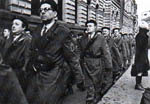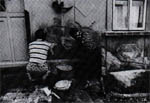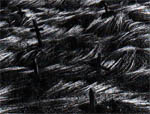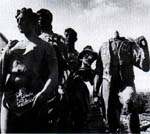TOTALITARIANISM ACCORDING TO
THE PHOTOGRAPHER: DID WE LIVE LIKE THIS?
PHOTOGRAPHS FROM THE COLLECTION OF THE
MORAVIAN GALLERY
EXHIBITIONS ON THE TENTH ANNIVERSARY OF THE VELVET REVOLUTION
Antonín Dufek
How big does an exhibition have to be to cover "totalitarianism"? Would an Us 1948-1989 exhibition consisting of over 470 photographs by a hundred of the best-known photographers in the erstwhile Czechoslovakia, suffice? Apparently not. So, the exhibition includes post-revolution publications on totalitarianism, August 1968 and November 1989, as well as original albums compiled by photographers on this occasion and never previously published, in which the authors present their own visions of the past. The photographic exhibition is complemented by paintings, referred to in a separate publication.
Two smaller exhibitions pick up aspects of the main theme with individual presentations. The first is an unpublished series of photographs by Jind?ich ·treit from Sovinec, confiscated by the StB (Státní bezpeanost, the "state security police") in 1982 as evidence of his criminal activities, for which he was arrested; they were returned after the revolution and subsequently purchased by the Moravian Gallery. After 17 years, we will all be able to see testimony in this unique series to life under Czech "socialism" - a term that fell, somewhat strangely to Czech ears, under the heading of "communism" in the West. We shall be reminded of the kind of material that surreptitiously reached not only the StB and some communists, but also the apparatchiks in the Association of Czech Photographers (which cannot help but occasion particular glee). It lends support to the idea that all the special interest groups, right through to the Gardeners’ and the Anglers’ Union and so on, served the communists. The second complementary exhibition extends to time beyond 1989, concerning the present directly. In contrasting pairs of photographs entitled 89/98 by the Brno amateur photographer Petr Daniel, the pre-revolution past meets the present. Is everything so different today? Is something the same in a different way? Is capitalist normalisation more successful than the socialist variety?
In any case, there are enough photographs on display to remind us of the past, sometimes scaldingly vivid, sometimes deliberately or not-so-deliberately forgotten. However, is there any sense at all in recalling, instead of ten years of a new régime, forty years of the old one? To allow us better to appreciate what the non-velvet present holds? To provide many with a window for nostalgic memories? To add to the general weariness about the past?
The exhibition is not for those who want to forget about the past. This does not alter the fact that ten years after the Velvet Revolution it might be good to look back and try to define our current position in relation to totalitarianism, so indiscriminately denied and yet so often and so palpably present, even if the gap has not yet opened up sufficiently for clear vision. It is possible that our social life is ruled by the present and aims at the future. (To the majority, the impatient citizens, post-revolution dreams only come true with an incomprehensible delay.) We try to avoid the past by every means at our disposal, and are therefore condemned to live in it still. In the absence of sufficient reflection, one parts from the past gradually, only without the desired and immediate impetus. The exhibition will probably have a particular appeal to that small group who want to trace the past as they carry on into the present. But they are far from being the only interested group in town.
Ten years is more than enough for the exhibition to mean one thing to those who, in the communist days grew up as politically aware members of society, and another to today’s younger people. The latter, with modern ideas create their own relationships with the past, unburdened by memories. They also start anew the process of classifying the photographs, holding off the moment when time’s curtain falls on them, preserving them in the social conscious and unconscious.
For all the hope we have invested in recalling the past, the exhibition has little chance of obtaining praise even from those who remember, and it will certainly inspire its share of loathing, too. (This has already been highlighted by the fact that, in comparison with politically neutral exhibitions, it has had virtually no support from sponsors.) It will hardly represent a challenge for those who remember and seek a balance between past and present, but it may contribute, or revive resolution within the currently comatose decision-making process that discriminates between past and future. Anyway, for young people, the exhibition could represent a chance to improve their understanding of the sources of the present, a chance to realise that the word "Us" in the title also involves them, to the extent that they are their parents’ children. Even those who cannot remember will have to come to terms with the trauma and phobia from the past. And yet, the "Us" in the title of the exhibition should also function as a permanent appeal to differentiate between "I/Me", "Us" and "Them".
HOW THE EXHIBITION CAME INTO BEING
This exhibition is a turning point for the photographic collection of the Moravian Gallery. For the first time in its history, it is housing an exhibition that is not about photography, but about what is photographed. In an artistic institution, this change is typical of the present, overdosed as it is with self-centred art and inclining to all forms of communication with the problems of today. At the same time, it finds continuity with the long-held dream of the avant-garde, of the usefulness of art, and also of the merging of art and life.
Photography in particular was long meant to become a kind of art that anyone could do. Although not everyone is an artist, photography, as everybody knows, is something that creates itself and, besides, it is firmly rooted in realism. According to this point of view, we should judge the value of a photograph by what it depicts - a theory that, to some extent, holds up. Unfortunately, a large body of significant things have probably never been photographed at all. All too often, the ever-present, the commonplace, was what was overlooked, while oddities and unrepeatable events were photographed by everyone. Despite a long-term effort at gathering together pictures of totalitarianism (our thanks to everyone who responded), we know we have been tilting at a particularly tricky windmill. Our exhibition contains lacunae, missing reports on some generally familiar phenomena, and will certainly be criticised for it. In truth, not everything is there, and so not everyone will find their pet memory.
There is another reason for the absence of photographs covering notorious acts and facts. None of the photographs exhibited is simply about its subject; the images imply more, something else that is often invisible. There is a certain difference between the former, the âTK (âeská tisková kancelá?, the Czech Press Agency) photographs and the documentation of the present deliberately (and often very well) staged by museums. The photographs that remain faithful to their topics are usually unambiguous; on the other hand, the photographs exhibited should be able to stand up to at least two angles of vision. In the relatively straightforward context of the exhibition, only photographs good enough not to be "worn away" by the context could be included, otherwise the whole display would become boring after only a few photographs. Good photographs can then present their own, unseen facets in unexpected contexts. In contrast to the manner in which aesthetic matters are perceived in this country, the way in which documentary photographs are viewed is critically inadequate, and the question remains as to what extent the viewer may benefit from the abundant meanings implicit in the work presented. The maze of "mirrors with a memory" reflecting nonadhering splinters of living, will be assembled differently in the minds of every viewer.
In the course of the selection of the photographs, it emerged that there are too many high-quality works in the Moravian Gallery collection. Approximately one-third of the original selection had to be dropped, and cycles and series had to be pruned back without mercy. Only a minimum of non-collection works, the admission of which is being negotiated, can be included in the exhibition. Let us hope that what the visitor definitely misses among the topics, he or she will find "dissolved" and invisible in other photographs as a cryptogramic part of their statement.
The multiple meanings contained within photographs gave rise to particular difficulties in the categorisation of the exhibition. Attempts to sort out the photographs according to a single criterion were the first to fail. The only worthy criterion might have been chronology, but the exhibition would then hardly have differed from routine art-historical presentations. Eventually, each section of the exhibition was given its own criterion, overlapping with other sections at the same time. The huge Society (taking up around a third of the show - an exhibition within an exhibition) was the last to be assembled. One good reason for this lack of order is the fact that, by being included in various parts of the exhibition, the pictures suffer a minimum of molestation or reduction of impact. They are displayed according to the photographers’ topics. The fact that the Society series is the largest one constitutes an honour for the photographers: the breadth of so many photographs is either so vast or so special that they cannot be subject to a more limiting and specific categorisation. Listing the titles of the sections gives a fair idea of what the exhibition is all about: Events, Festivals, Signs and Slogans, Work, Environment, Celebrities in Social Life, Sport, Alternative Culture and Society. The exhibition is not just about the régime. Besides, it is quite difficult to photograph solely and only a régime. Still, each of the photographs evokes - within the given context of the exhibition - the communist regime. Otherwise there would be no place for it. It is hardly surprising that documentary works dominate the selection of photographs, in testimony to as broad a view of life under communism as possible. It is an exhibition about how we lived. However, it is necessary to know something of the specific features of communism, such as collectivism, planning, the politicisation of public life, programme optimism and so on, to recognise them as more or less visible components of the displayed works. The axis of the exposition is factualness, everyday reality; however, the official self-image of the regime is always present in the background ("We will drive mankind to happiness with an iron fist!"). The relationship between the reality depicted and the official ideology appears to be the main source of tension as one observes the exhibited works.
According to photography, then, what was totalitarianism like? Great expectations can be vested in the photographs, and it is then pleasant to find that not only do the expectations remain unfulfilled, but that they are superseded and satisfied in unforeseen and different ways. For example, the theme "ploughing away the balks" may be missing (pictured, for example, in an "avant-garde" way by the Brno photographer Antonín Koutník). Nevertheless, there are surprising pictures of the black market, police activities, indoctrination, work, and the working environment. The statements contained within the photographs, many of which were previously unknown, are extraordinarily forceful. They will certainly inspire anything but indifference.
According to photography, totalitarianism only occasionally makes itself visible, but especially during festivals (which were accordingly considered of great importance). In everyday life, it is present in the form of voluntary work, meetings and other collective events. It is permanently present in the shape of slogans, noticeboards, and decorations. Up to 1968, everything looks idyllic (e.g. VoIenílek), or is the rough and simple reality of the hard working life, particularly in the Ostrava region (Kolá?, Poláaek). Criticism is reduced to mere comment; smoking factory chimneys still proclaim pride in the power of Czech industry. In this context, Saudek’s striking Hey, Joe! (1959), its new colour version becoming it well, appears far more of a shock, evidence of the existence of people thinking in a different way, and perhaps also living in a different world. There could not have been a more suggestive way of projecting an American horizon on to Prague. Isn’t that James Dean himself, sitting on a cool motor-bike by the Charles Bridge with a crate of whisky on the pannier?
After 20 years of totalitarianism, from 1968 onwards, every-thing turned away from the human to the inhuman. Photography could not document the worst evils of Stalinism; it could, however, capture the escape from the unreal reality that followed. (It was up to Saudek again, working in 1969, in a picture of a child leaving a city, to provide the most impressive symbol of an escape from "civilisation". Even if Saudek was inspired by the hippie movement, this still remains, in terms of life and institutions, and in meaning, a purely domestic work and also a fairly private one.) Photographers described "negative" as well as "positive" forms of escape into privacy (beer drinkers, people with weekend homes and dachas). Some of them understood ecological problems, started to learn from sociologists, and infuse their work with system. In the 1980s they defined the absurdity of the artificially preserved ideology and the ruling order with ever greater precision. In the photographs from festivals there emerges a distinctly less covert resistance to the régime, encompassing its downfall. The May First festivities in particular became a perennial source of photographs that were a far cry from the cheering and celebration of previous works. Ivo Loos and many after him created a new theme and a new tradition: within the festivities they found the opportunity to unmask the absurdity, the misery, and the brutality of the régime. In the late 1980s, for the photogra-phers of the Bratrstvo (Brotherhood) group, totalitarianism was a finished aesthetic attempt. Forms of it could be utilised as components of further work.Totalitarianism according to photography is, however, also the time of "quite ordinary, plain days", to paraphrase a 1950s song. Officially, cordiality, simplicity, frankness, and compassion, the most general ideals of humanity, rule. There is friendship and love, the family; there are children and old people. Photographers manage more and more often to sneak into old people’s homes, corrective institutions for juvenile delinquents, and asylums for mentally handicapped youth. Religious feelings, folk customs and festivals, or the life of the Romany people do not escape the lenses either. The popular city culture of the Semafor Theatre (Traffic Light) peaked around this time until, despite the iron curtain, competition from the Beatles intruded. In the Czech lands and in Slovakia lived personalities into whom crowds, or at least small groups of the initiated, projected themselves. Cele-brities from all social fields became lighthouses in a sea of nonsense; they represented a necessary degree of scepticism and character, and they knew the value of the truth. Life without them would have been different. Also, the alternative art of "happenings", "actions", events, performances, installations, land art, body art, and so on, largely documented by photography was able to demystify through mystification, define through games, and explore social topics that were otherwise taboo.
ON PHOTOGRAPHY
The exhibition that was not meant to be about photography is, naturally, about photography. Historical changes in the way photographs are taken influence the selection of the reality photographed. In the 1950s, the extraordinary craft of shooting large, illusory wholes is evident, together with the importance, even reverence, associated with light. Genre pictures gradually evolve into the photography of humanism, in the sense of Steichen’s Family of Man. Burian, Hrub˘, Chochola, JírU, Lukas and later Hochová and Novotn˘ are the stars of this phase. Reportage based on photojournalism found its feet, especially after the stimulus provided by the publication of the works of Henri Cartier-Bresson (a monograph by Anna Fárová, 1958).
Koudelka’s Gypsies and Luskaaová’s Pilgrims demonstrate the trend towards documentarianism, in which a single shot of an event or situation, preferably with a touch of humour, and a lacking of any need whatsoever for the photographer to know anything about the subject, is not enough. Documentary photography developed most strongly around 1980. Most photographers were grouped around Anna Fárová. The series of exhibitions in âinoherní klub (The Drama Company Club) in Prague peaked in a monumental event in Plasy. Further groups and centres were formed (Dokument, Oai [Eyes], Galerie F). The need for association became urgent and pressing. The exhibition demonstrates the extraordinary levels reached by other documentarists. Jind?ich ·treit discovered the village, a theme of enormous potential. At the other extreme, Viktor Kolá? chose the industrial town of Ostrava. Pavel ·techa engaged in a fruitful collaboration with sociologists (MatujU, in particular) - although even without them, his results are still excellent. Jaromír âejka represents the photographic intelligentsia. Holomíaek’s original snapshots stand out all the more strikingly when presented among other pictures, as if they were connected to their auteur by an umbilical cord, as if everything was within reach of them; totalitarianism probably has no more trustworthy or more comprehensive witness.
The works of these artists are not totalitarian; they are works of free personalities par excellence. To work in order to retain a sense of dignity and a feel for life, without hope of publication or profit - or even covering costs - under the shadow of real political oppression, requires courage and integrity of a very high order. In the regime that passed, the documentarists, including those who worked in film, were artists who lived up to that standard and they produced work of the greatest significance for us all.•

Dagmar Hochová,
Lidová milice, 1973

Jiří Hankr,
Lidé pod průhonem, 1982

Martin Martinček,
In the Old Cemetery,
from the series Cradle,
1968

Vilém Reichmann,
Retreat from Glory, 1956